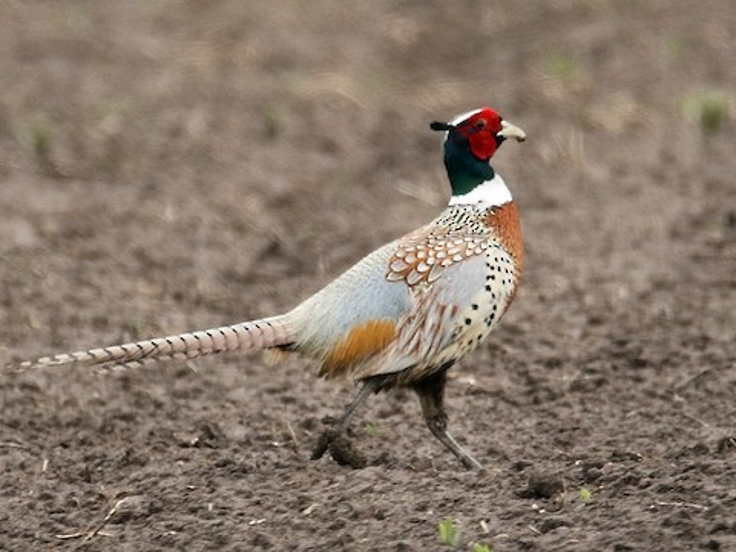Birdfinding.info ⇒ This quintessential gamebird is locally abundant in many areas where it has been introduced for hunting: especially in agricultural areas of Europe and North America, and on many Pacific islands, including all the main Hawaiian Islands. Across much of its native range, it is comparatively inconspicuous, but it remains locally common in central and eastern Asia (Kazakhstan, Uzbekistan, South Korea, Taiwan, and several parts of China). The English name generally used in North America, “Ring-necked Pheasant,” describes many populations but not all (especially not the “Black-necked” form), and is probably best discarded in favor of the descriptively neutral Common Pheasant. Centuries of management for hunting—including selective breeding and innumerable introductions—have blurred the boundaries between forms that were formerly distinguishable.
Common Pheasant
Phasianus colchicus
Southwestern, central, and eastern Asia; widely introduced elsewhere. Thrives in open plains, agricultural zones, light woodlands, and mixed habitats, including parks with lawns.

Approximate distribution of Common Pheasant across North America and Eurasia (native range shown in orange). © BirdLife International 2016
Historical segregation across its native range resulted in five main population clusters with somewhat distinctive characteristics. From west to east, these are:
“Black-necked Pheasant” (four subspecies): the Caucasus and Caspian lowlands from the Volga Delta and Georgia to southwestern Turkmenistan; widely introduced in Europe.
“White-winged Pheasant” (five subspecies): west-central Asia in Uzbekistan, Turkmenistan, and adjacent parts of Iran, Afghanistan, and Tajikistan.
“Kyrgyz Pheasant” (two subspecies) central Asian steppes of Kazakhstan, Kyrgyzstan, and adjacent parts of Uzbekistan and northwestern China (Xinjiang and Urumchi).
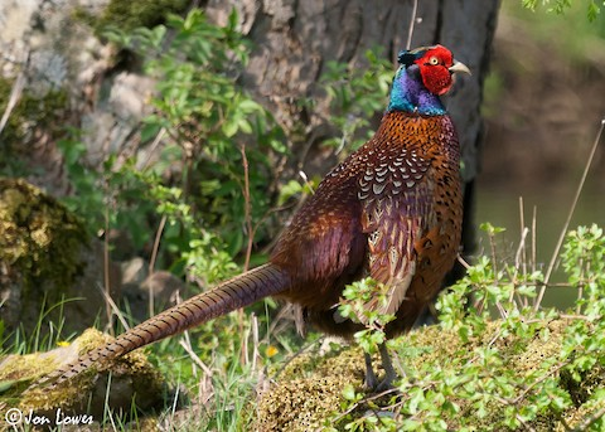
“Black-necked Pheasant,” male. (Upperdale, Derbyshire, England; April 19, 2011.) © Jon Lowes
“Tarim Basin Pheasant” (two subspecies): the Tarim Basin in western China.
“Gray-rumped Pheasant” (seventeen subspecies): eastern Asia from western Mongolia and eastern Siberia south to northern Myanmar, northern Vietnam, and Taiwan; widely introduced worldwide.
Introductions of “Black-necked Pheasant” for hunting began in Europe in the Middle Ages, or possibly earlier, and it is well-established from the British Isles and southern Scandinavia to the Mediterranean, and east to Ukraine, Turkey, and the Caucasus—contiguous with its native range. In recent centuries, introductions of “Gray-rumped” and “Kyrgyz” forms augmented the older stock and complicated the ancestry of most European populations.
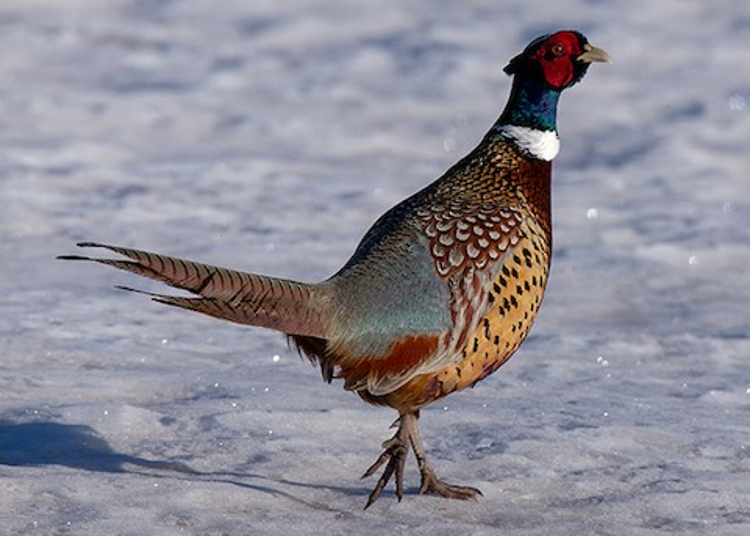
“Gray-rumped Pheasant,” male. (George W. Mead State Wildlife Area, Wisconsin; March 17, 2019.) © Lori Widmann
In North America, “Gray-rumped Pheasant” has been introduced widely and is well-established across most of southern Canada and the U.S. (but only locally in the southeast), and marginally south of the border in the Mexicali Valley of northwestern Mexico.
Introduced populations, mainly of “Gray-rumped,” are also well-established in several areas around the Pacific: southern Hokkaido; the Ryukyu Islands; the main Hawaiian Islands; the Río Simpson area of southern Chile; New Zealand’s North Island and the eastern lowlands of South Island; and very locally in southern Australia (mainly King Island in Bass Strait, and more tenuously elsewhere, including Flinders Island, eastern Tasmania, and around Perth).
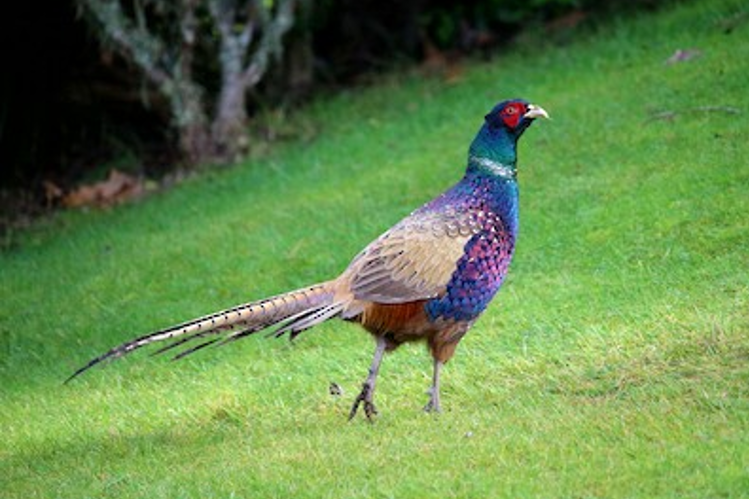
Common Pheasant, male of mixed heritage. (Huka Falls, Taupo, Waikato, North Island, New Zealand; May 9, 2017.) © Gus Go
Further introductions continue worldwide, so feral individuals may be encountered anywhere. However, attempts to introduce Common Pheasants into the range of the Green Pheasant (mainly Honshu, Kyushu, and Shikoku) have failed—and this failure is regarded as persuasive evidence that the two are separate species.
Identification
Male plumage is exceptionally variable, which appears to result from two main factors: (1) natural diversification among the thirty-or-so recognizably distinct populations across its native range spanning the full breadth of Asia; and (2) subsequent hybridization resulting from introductions from multiple populations worldwide.
Only the head and tail are strongly consistent across all populations. The head is iridescent dark-green and/or violet, and the tail is long and thin, with a ladder-like pattern of dark bars. In breeding plumage, the male’s face is ornamented with large, bright-red wattles and dark-feathered “horns.”
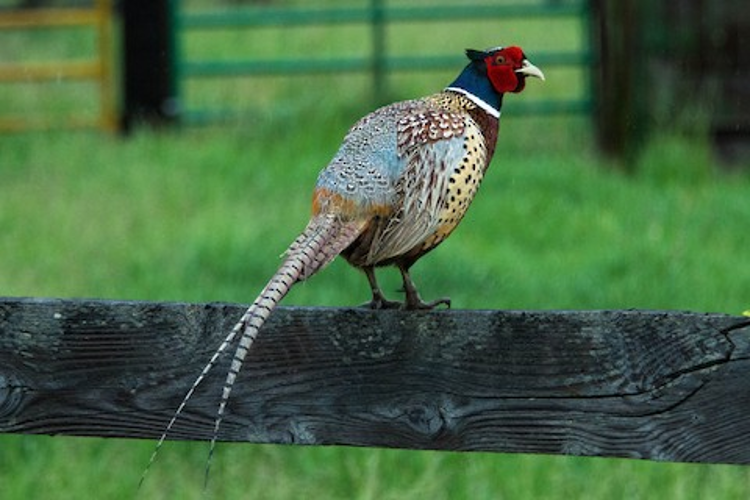
“Gray-rumped Pheasant,” male showing green, horned head and barred tail. (Ukiah, Oregon; May 15, 2016.) © Joshua Little
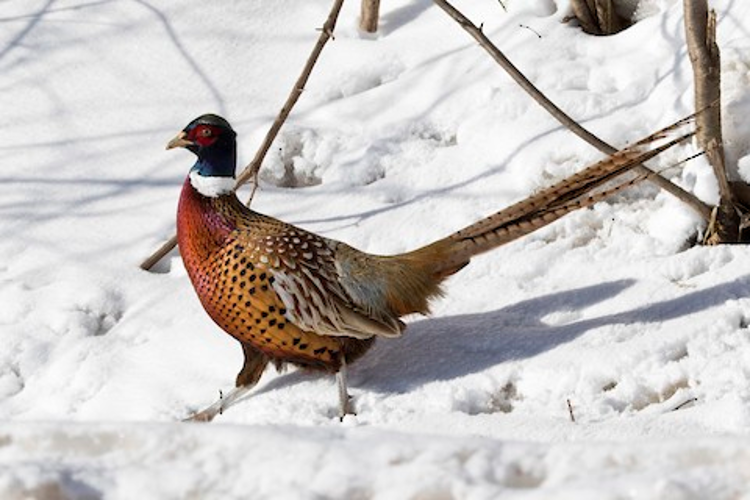
“Gray-rumped Pheasant,” male. (Lett’s Creek, Michigan; February 12, 2015.) © Michael Bowen
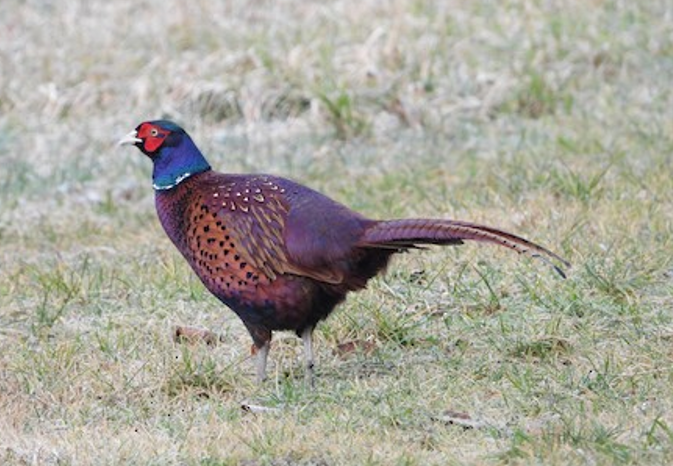
“Black-necked Pheasant,” male. (Mondsee, Austria; February 17, 2020.) © Thomas Ebner
Most males have a scalloped pattern on the upper back, and sides that are pale with large black spots, but coloration throughout the body varies widely. In areas that have received introductions from multiple populations, males exhibit various combinations of features that are typical of one population or another.
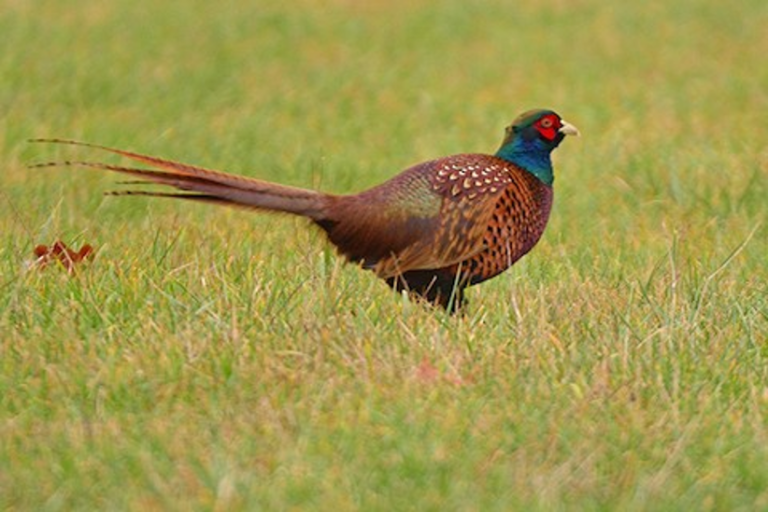
“Black-necked Pheasant,” male. (Ahsewiesen, Nordrhein-Westfalen, Germany; December 14, 2018.) © Guido Bennen
There appear to be almost innumerable variants, but a handful of basic appearance-types are often recognized. The simplest distinction is between the “Black-necked” of western Asia and the “Ring-necked” of eastern Asia—however, the presence of white neck collars is a matter of degree, and becomes inconsistent in central Asia. In addition, the many “Ring-necked” subspecies are highly variable in other features.
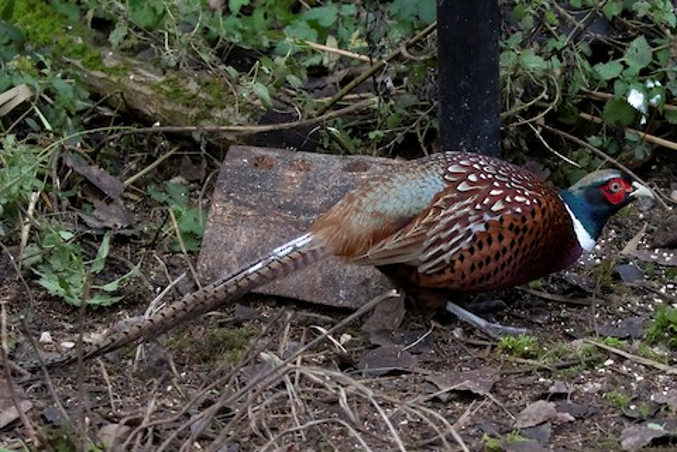
“Gray-rumped Pheasant,” male. (Langford Lakes Nature Reserve, Wiltshire, England; November 20, 2019.) © Bob Wood
With those caveats, the five geographical reservoirs of Common Pheasant stock can be narrowed to three simplified plumage-types: “Black-necked,” “White-winged” and “Gray-rumped.”
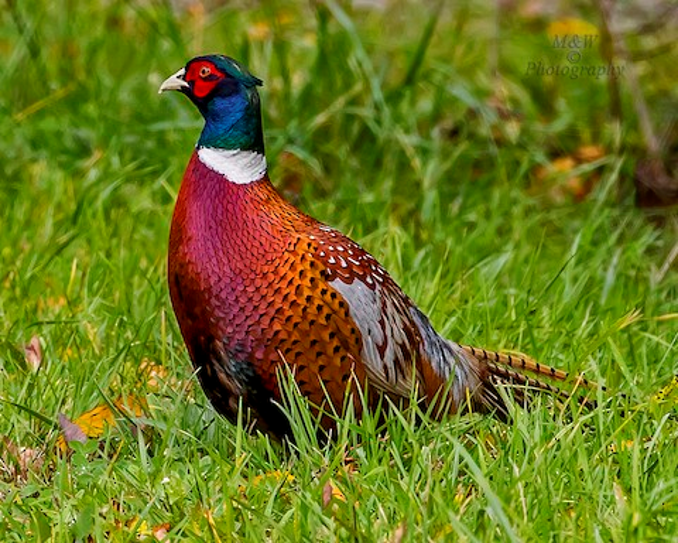
“Gray-rumped Pheasant,” male. (Scotts Bluff, Lake Shore Marshes Wildlife Management Area, Wayne County, New York; November 3, 2016.) © Wade & Melissa Rowley
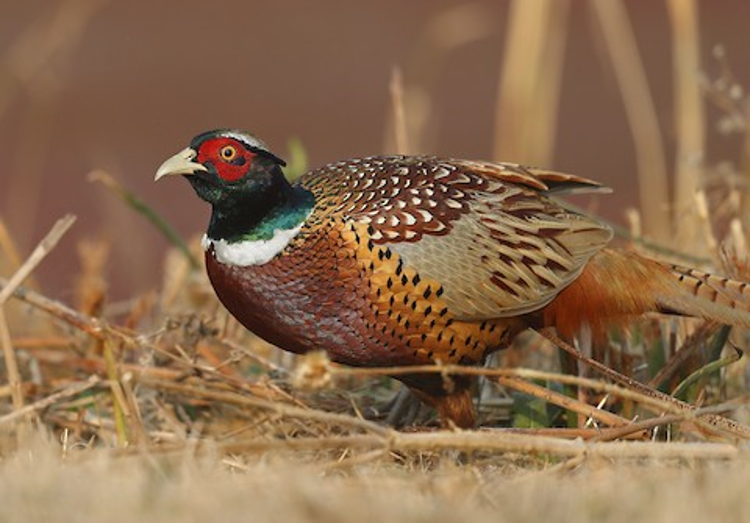
“Gray-rumped Pheasant,” male. (Sacramento National Wildlife Refuge, California; November 17, 2018.) © Matt Davis

“Gray-rumped Pheasant,” P. c. pallasi, male. (Gayvoron, Primorskiy Kray, Russia; May 28, 2019.) © Pavel Parkhaev
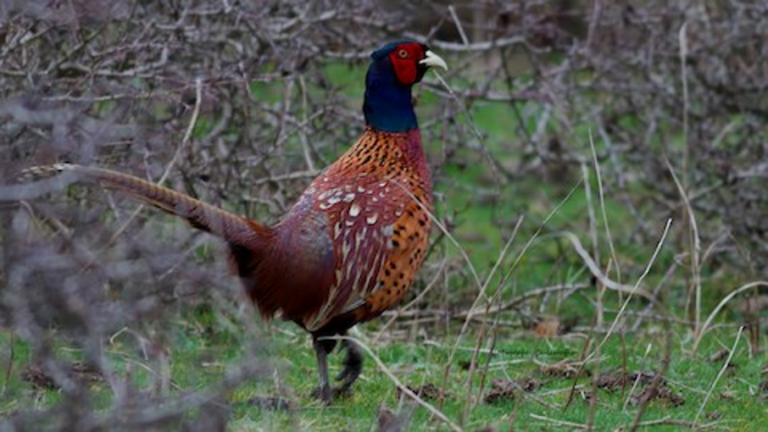
“Black-necked Pheasant,” male. (Kızılırmakdeltası, Samsun, Turkey; January 18, 2018.) © Mustafa Çulcuoğlu
“Black-necked Pheasant” has the simplest plumage pattern: a dark-green and violet head and neck, and mostly warm-brown body that varies from bright coppery to rufous to purplish. The geographically distant “Tarim Basin Pheasant” is similar in overall appearance.
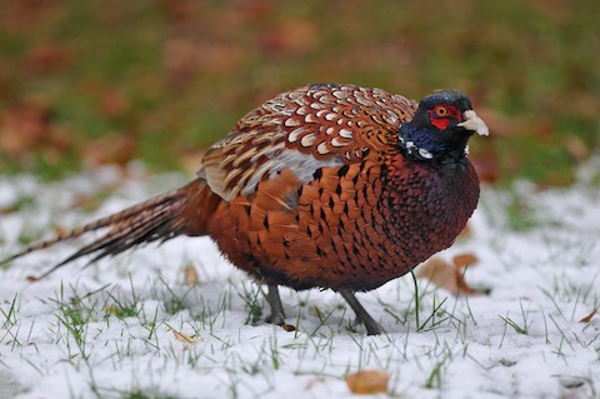
“Black-necked Pheasant,” male. (Merikarvia, Satakunta, Finland; October 17, 2013.) © Seppo Niemispelto

“Black-necked Pheasant,” male. (Lavells Lake, Berkshire, England; November 22, 2019.) © Samuel Rusu
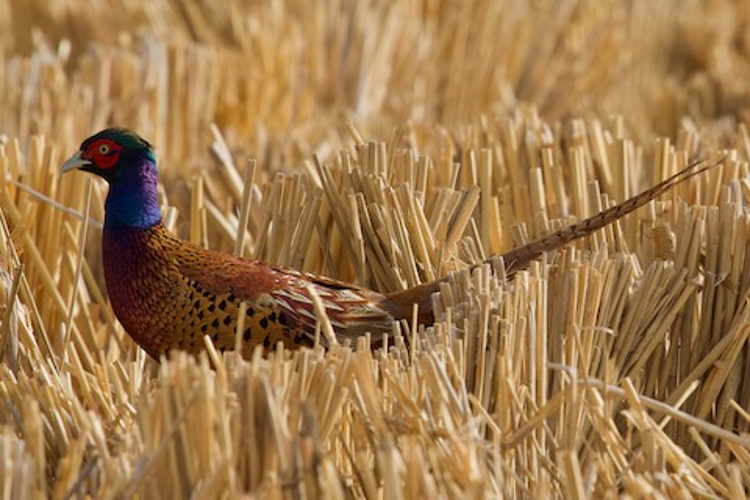
“Tarim Basin Pheasant,” P. c. shawii, male. (Aksu, Xinjiang, China; May 12, 2019.) © Qin Huang
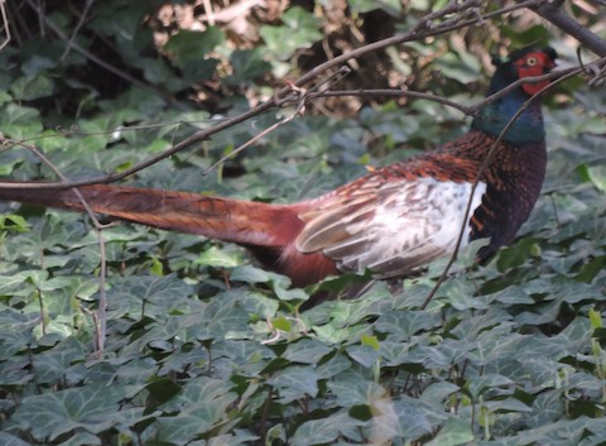
“White-winged Pheasant,” P. c. principalis, male. (Ashgabat Botanical Garden, Ahal, Turkmenistan; March 28, 2015.) © Yoshio Akasaki
“White-winged Pheasant” generally resembles the preceding forms, but has extensive white on the wings. “Kyrgyz Pheasant” generally resembles “White-winged” but has a prominent white neck collar—and its wings vary from white to buffy.
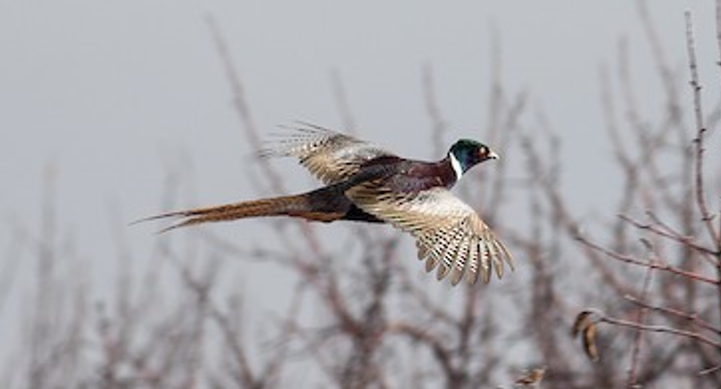
“Kyrgyz Pheasant,” P. c. turcestanicus, male. (Ahmet Yesevi University, Ongtüstik Qazaqstan Oblysy, Kazakhstan; January 2, 2020.) © İhsan Eroğlu

“Kyrgyz Pheasant,” P. c. mongolicus, male with white wings. (Almaty Oblysy, Kazakhstan; May 21, 2019.) © Frédéric Pelsy

“Kyrgyz Pheasant,” P. c. mongolicus, male. (Daquangou Reservoir, Xinjiang, China; November 3, 2019.) © Vincent Wang
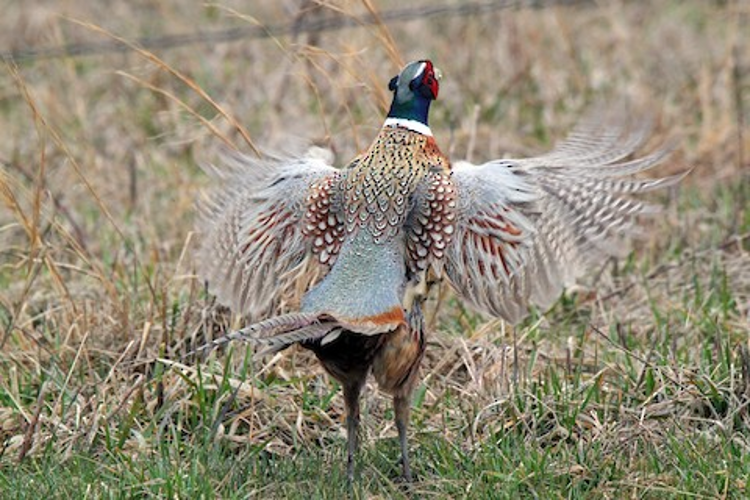
“Gray-rumped Pheasant,” male showing gray rump and lower back and scalloped pattern on upper back and scapulars. (Middle Creek Wildlife Management Area, Pennsylvania; March 30, 2018.) © Kristen Gates
“Gray-rumped Pheasant” refers to a diverse assortment of eastern subspecies that all have some amount of gray on the back and rump. Most have a prominent white neck collar, white browlines, and large patches of differing coloration on the upper back, breast, belly, and sides. However, some lack the neck collar and browlines, some are more uniformly dark brown, some have purplish-brown underparts, some are bright coppery or rusty-brown, and some are mostly pale-gray.
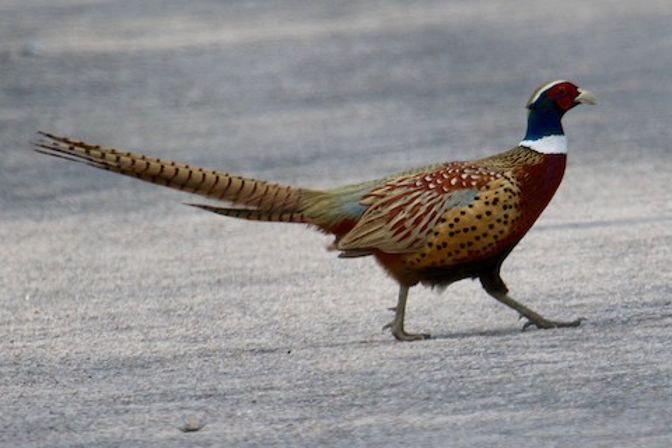
“Gray-rumped Pheasant,” P. c. karpowi, male. (Liaohe Wetlands Forest Park, Panjin, Liaoning, China; April 26, 2016.) © Owen Krout

“Gray-rumped Pheasant,” P. c. formosanus, male lacking white neck collar. (Donghe Dulan, Taitung County, Taiwan; May 15, 2019.) © 世彬 蔡
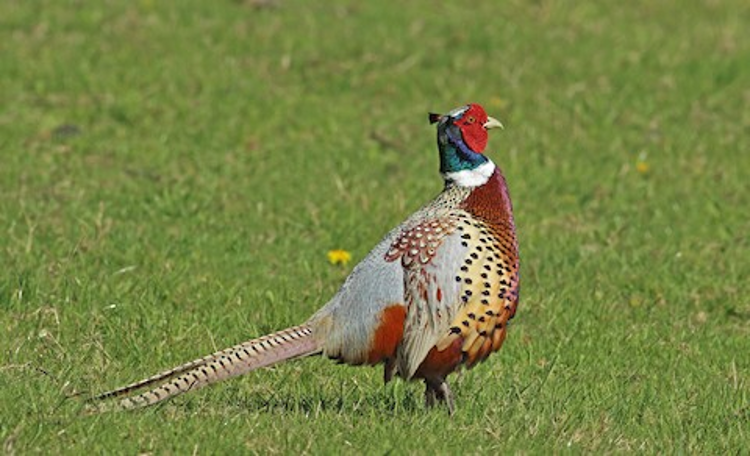
“Gray-rumped Pheasant,” male. (Gorhambury Estate, Hertfordshire, England; April 19, 2017.) © Andrew Steele

“Gray-rumped Pheasant,” male. (Logan River, Utah; January 26, 2017.) © Cullen Clark
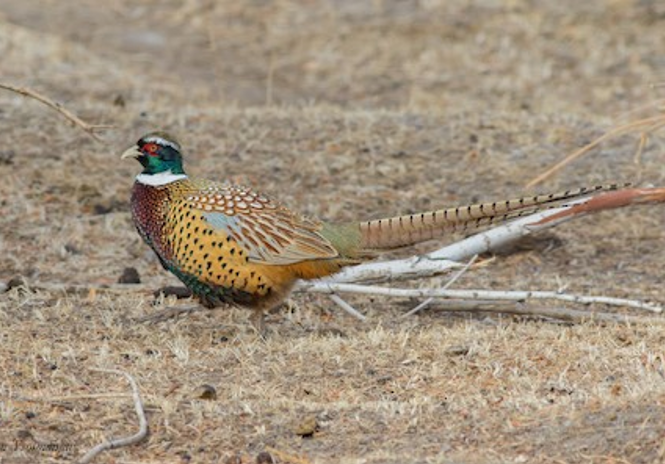
“Gray-rumped Pheasant,” P. c. hagenbecki, male. (Bayan-Ölgii Province, Mongolia; December 29, 2016.) © Purevsuren Tsolmonjav

“Gray-rumped Pheasant,” male. (Varna, New York; December 26, 2019.) © Jay McGowan
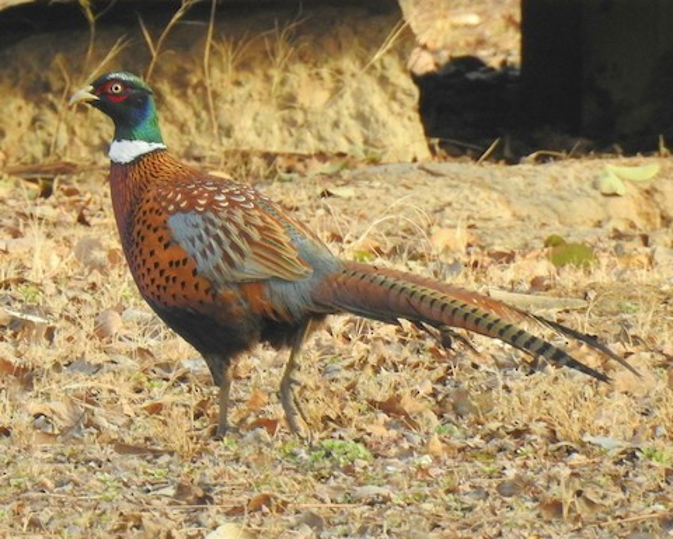
“Gray-rumped Pheasant,” P. c. strauchi, male. (Chanba National Wetland Park, Shaanxi, China; February 3, 2019.) © Scott Young
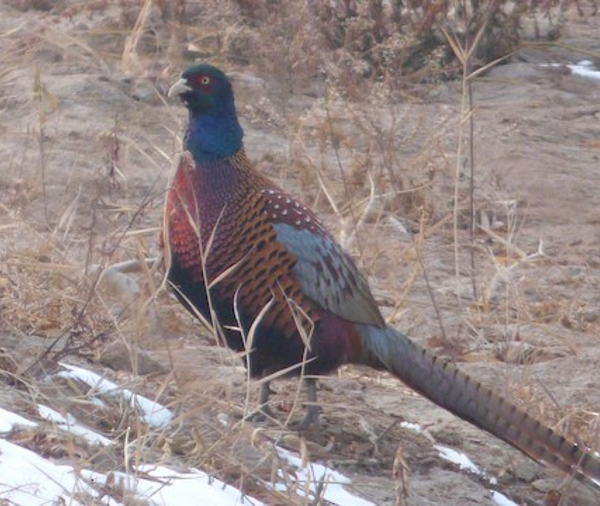
“Gray-rumped Pheasant,” P. c. strauchi, male lacking white neck collar. (Yintan Wetland Park, Gansu, China; January 8, 2020.) © Roy Kasius
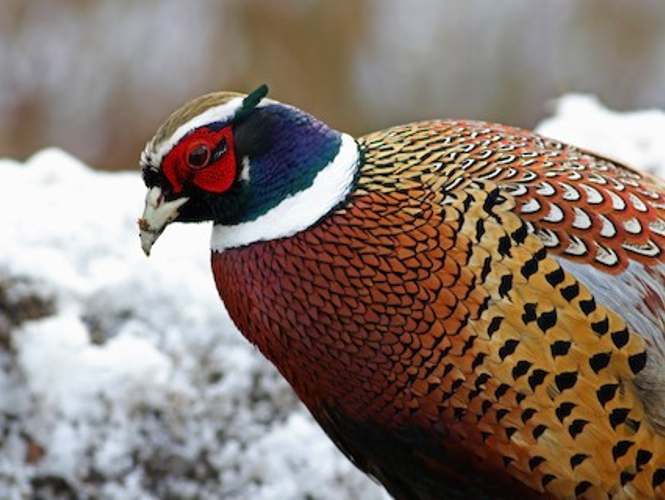
“Gray-rumped Pheasant,” male. (Ithaca, New York; January 25, 2016.) © Jay McGowan
Finally, some portion of the males found in Europe, North America, and New Zealand seem to be unclassifiable, with features that clearly indicate mixed ancestry.
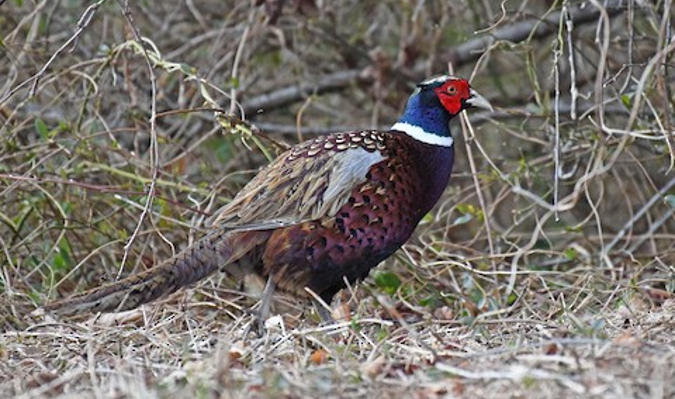
Common Pheasant, male with purplish underparts. (Plumsted Township, New Jersey; January 26, 2020.) © Peggy Cadigan
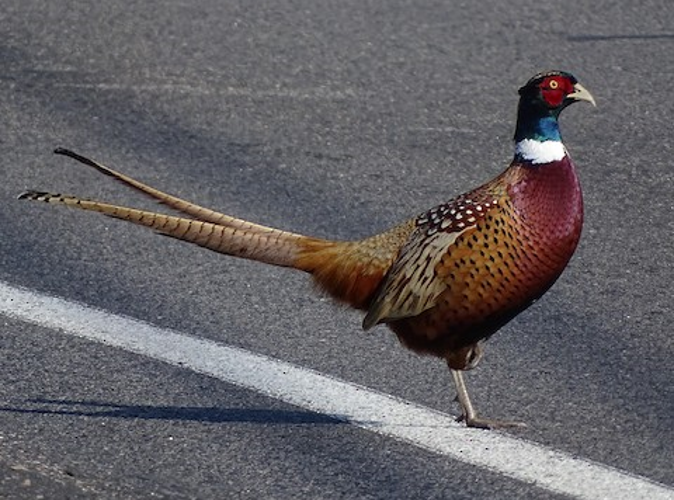
“Gray-rumped Pheasant,” male. (West Bridgewater, Massachusetts; February 28, 2018.) © Jim Sweeney
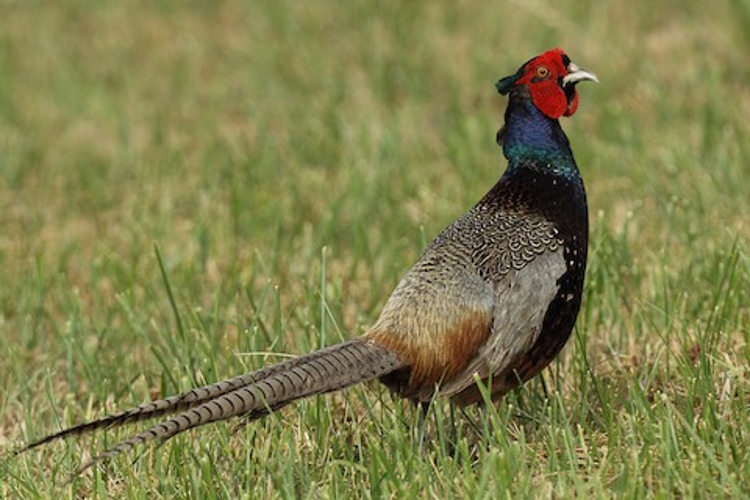
Common Pheasant, male. (La Sologne, France; June 21, 2011.) © Frédéric Pelsy

Common Pheasant, male showing a mixture of features of “Black-necked” and “Gray-rumped” (but not a black neck or gray rump). (Plaine de Dompierre, Freiburg, Switzerland; March 25, 2015.) © Patrick Monney
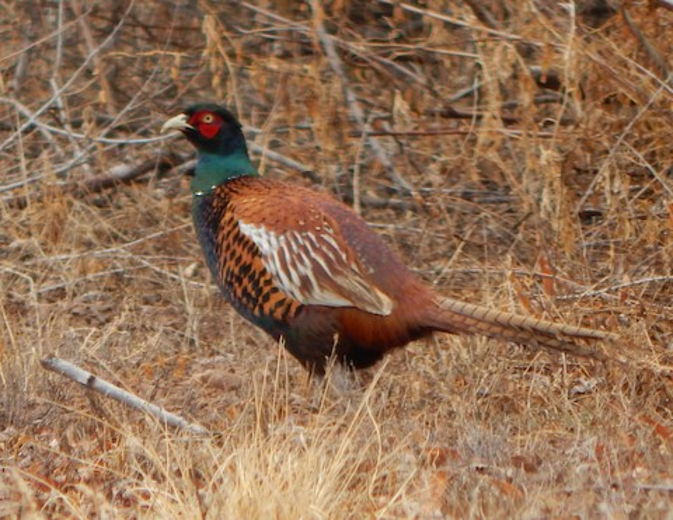
Common Pheasant, male. (Bosque del Apache National Wildlife Refuge, New Mexico; February 10, 2020.) © Brian Taber
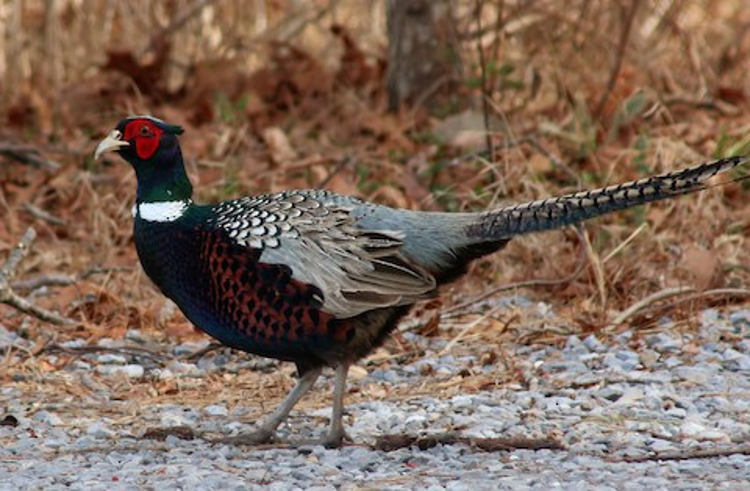
Common Pheasant, male with purplish underparts and pale-gray upperparts. (Calverton, New York; February 27, 2017.) © Brenda Bull
Females of all forms are cryptically plumaged: tan to grayish-brown, and variably marked with dark spots and scallops. The female’s tail is a shorter version of the male’s, with regularly-spaced dark bars.
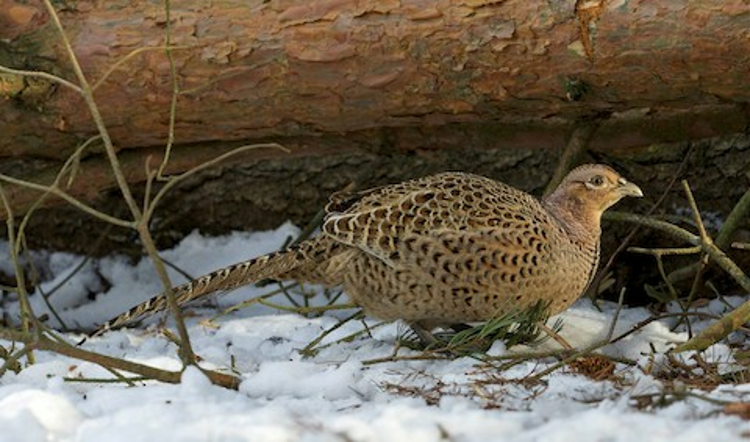
Common Pheasant, female. (Woodhorn Flash, Northumberland, England; April 7, 2012.) © Eric Barnes

“Gray-rumped Pheasant,” female. (Covert, New York; October 7 2013.) © Tim Lenz

“Gray-rumped Pheasant,” P. c. karpowi, female. (Royal Tombs Park, Seoul, South Korea; June 14, 2019.) © Jim Holmes
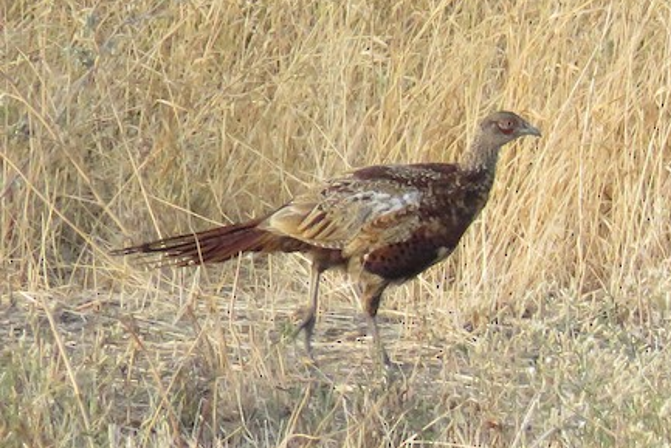
“Kyrgyz Pheasant,” P. c. mongolicus, immature male. (Bishkek, Kyrgyzstan; August 31, 2019.) © Eric Froelich
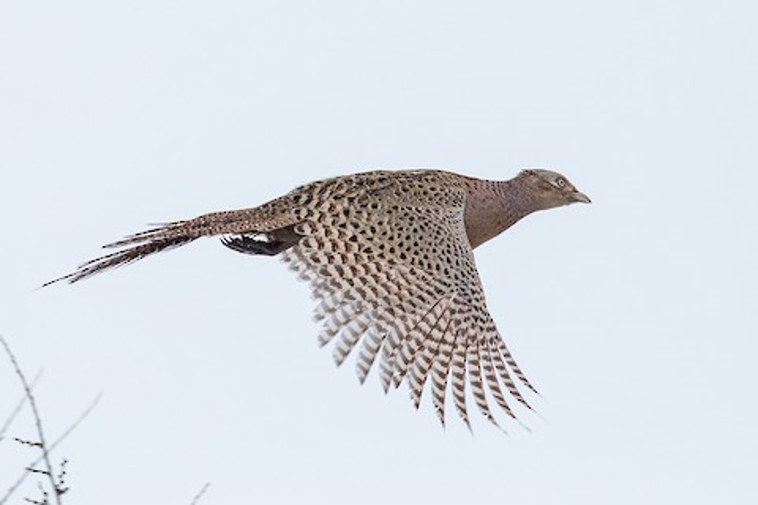
“Kyrgyz Pheasant,” P. c. turcestanicus, female. (Ahmet Yesevi University, Ongtüstik Qazaqstan Oblysy, Kazakhstan; February 16, 2020.) © İhsan Eroğlu
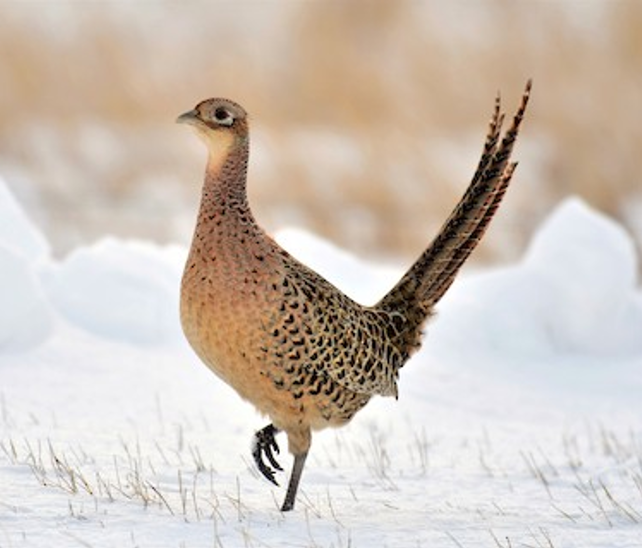
“Gray-rumped Pheasant,” female. (Edilou, Montana; February 14, 2020.) © Harold Ziolkowski
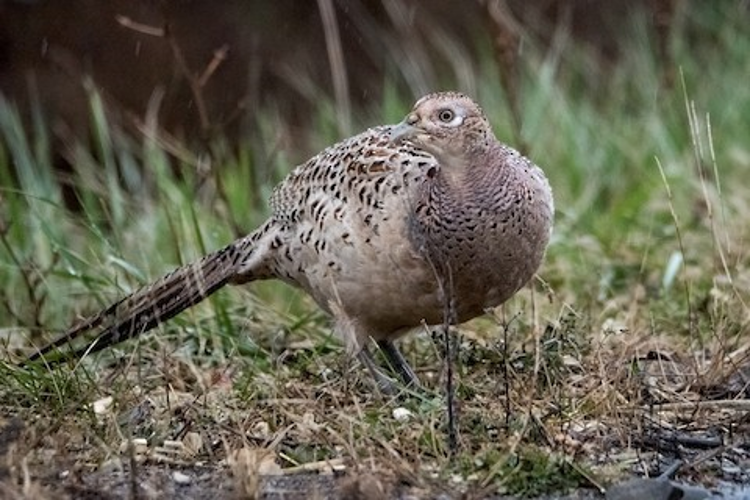
“Gray-rumped Pheasant,” female. (Cuba, New York; November 18, 2017.) © Sue Barth
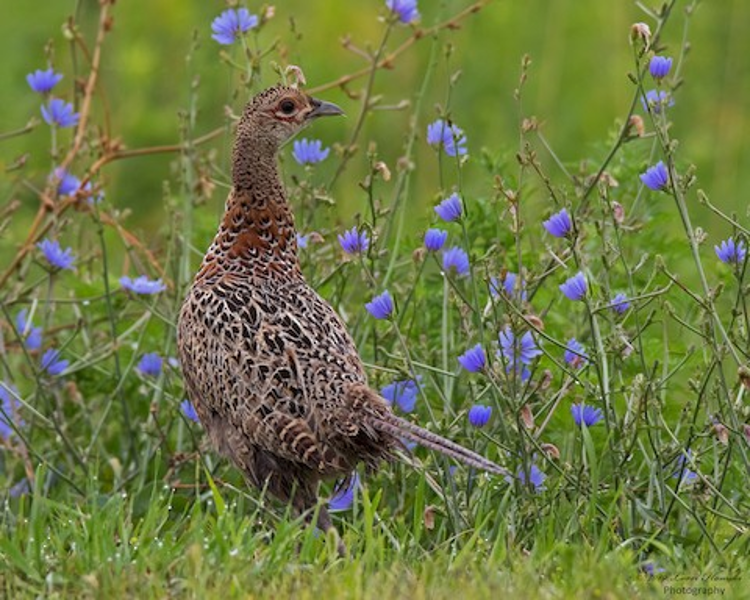
“Gray-rumped Pheasant,” female. (Horicon National Wildlife Refuge, Wisconsin; August 4, 2019.) © Lorri Howski
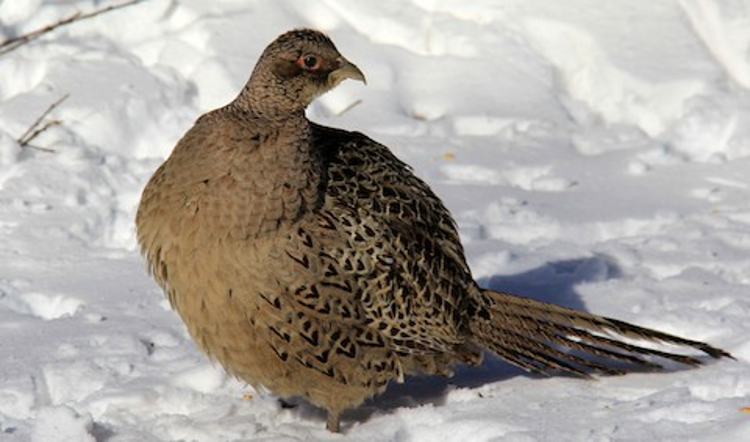
“Gray-rumped Pheasant,” female. (North Sea, New York; January 6, 2018.) © Stefan Mutchnick
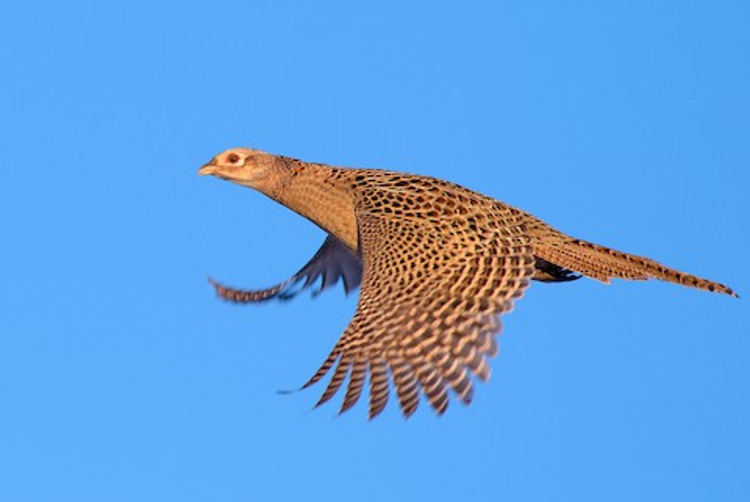
“Gray-rumped Pheasant,” female. (Nemaha, Iowa; February 15, 2020.) © Dana Siefer
Cf. Green Pheasant. The Green Pheasant is often regarded as a distinctive form of the Common Pheasant—which is exceptionally variable and includes some dark morphs that resemble the Green Pheasant.
Green and Common Pheasants are not known to occur together, so location is usually sufficient for identification. In cases where one has been introduced to an area occupied by the other, one remains while the other vanishes. This is the principal evidence on which they are now generally regarded as separate species.
There has been some confusion because some dark morph male Common Pheasants may have the same general appearance as a male Green Pheasant. Nevertheless, few if any dark morph Commons show exactly the same pattern as the male Green Pheasant. (See examples below of dark morph male Common Pheasants that share varying features in common with typical male Green Pheasant plumage.)

Green Pheasant, male showing diagnostic combination of features: dark-green body, violet head, and mostly pale-gray back, rump, and wings, coppery-brown scapulars. (Karuizawa, Nagano, Honshu, Japan; February 28, 2019.) © John Martin
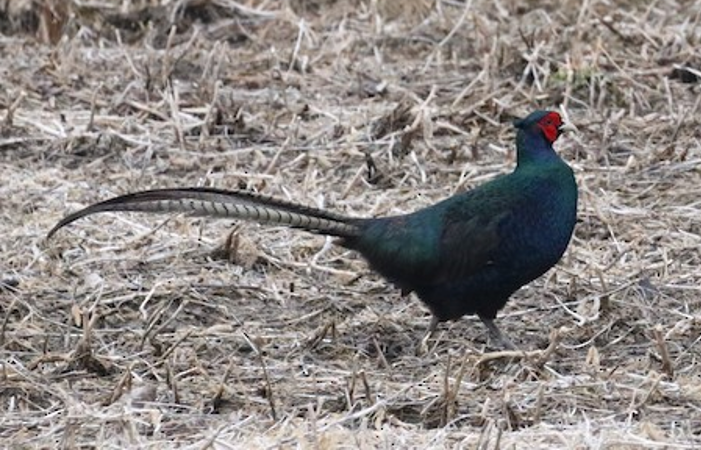
Common Pheasant, dark morph male with nearly uniform dark-green plumage. (Dover Plains, New York; February 1, 2020.) © Sean Carroll

Common Pheasant, dark morph male with pattern similar to male Green Pheasant—but note rusty flanks and vent, and lack of coppery scapulars. (La Sologne, France; June 21, 2011.) © Frédéric Pelsy
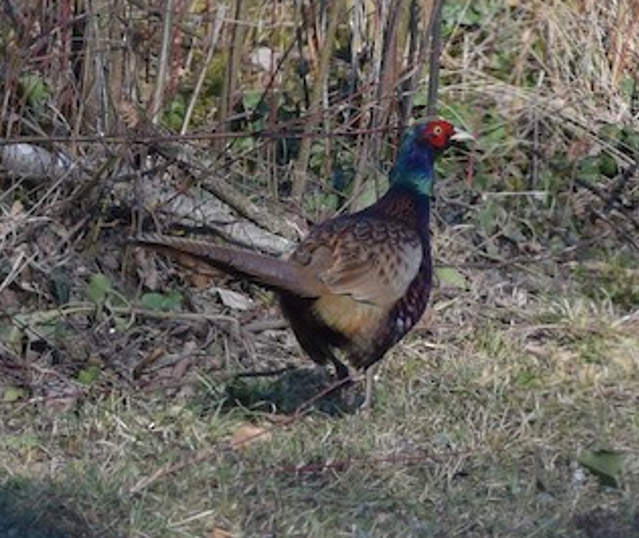
Common Pheasant, dark morph male with pattern similar to male Green Pheasant—but note general gray-brown upperparts, lacking distinct contrasting patches of Green. (Hard, Sankt Gallen, Switzerland; February 16, 2019.) © Lorenzo Vinciguerra

Common Pheasant, dark morph male with nearly uniform dark-green plumage. (Magescq, Aquitaine, France; April 20, 2019.) © Marc St. Onge

Common Pheasant, atypical dark morph male with mostly violet underparts and rusty-brown upperparts. (Hosmer Grove, Haleakala National Park, Maui, Hawaii; May 19, 2012.) © Robert Tizard
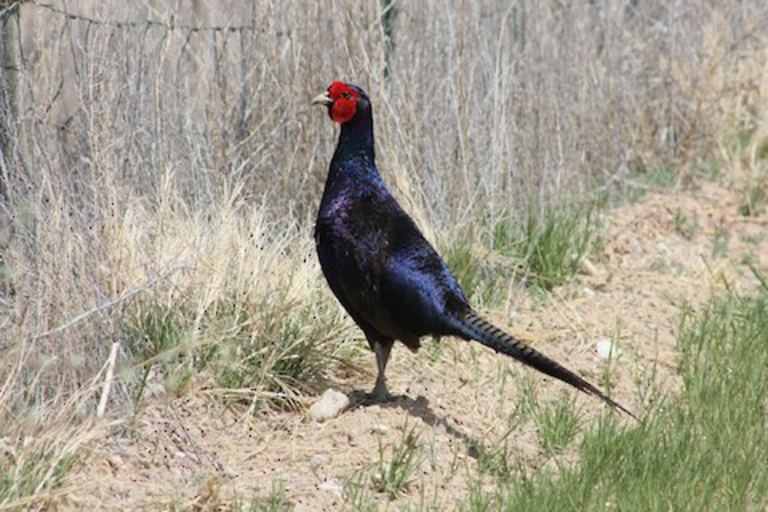
Common Pheasant, dark morph male with nearly uniform violet plumage. (Kevin Conway Wildlife Management Area, Utah; April 27, 2015.) © Tory Mathis
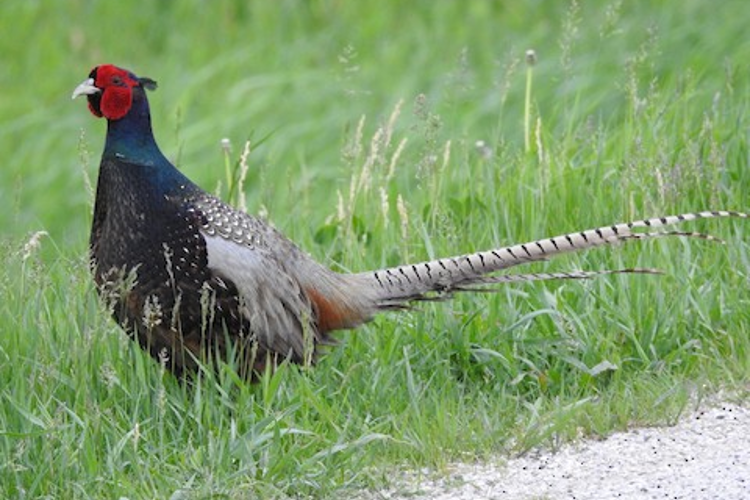
Common Pheasant, dark morph male with pattern similar to male Green Pheasant—but note rusty flanks and vent, and lack of coppery scapulars. (New Holstein, Wisconsin; June 3, 2018.) © Annie and Paul Mueller
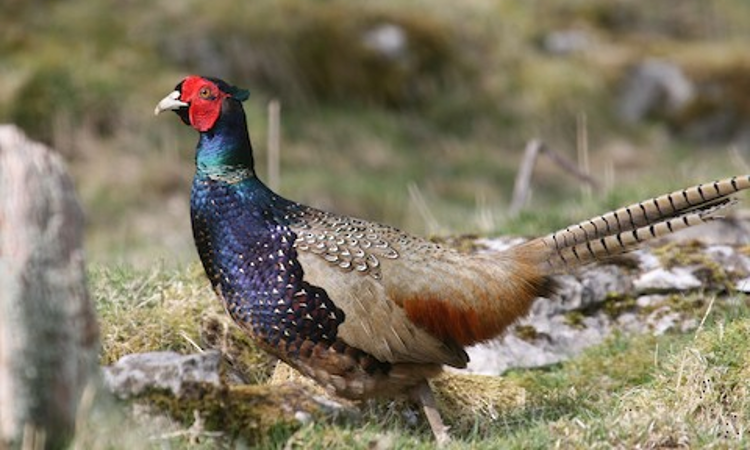
Common Pheasant, dark morph male with mostly violet underparts—note also the partial neck collar, rusty flanks and vent, and lack of coppery scapulars. (Ulverston, Lake District National Park, England; July 23, 2019.) © Peter Turner

Common Pheasant, atypical dark morph male with largely dark-green underparts, rusty-brown upperparts, and white on the wings. (Bosque del Apache National Wildlife Refuge, New Mexico; February 10, 2020.) © Brian Taber
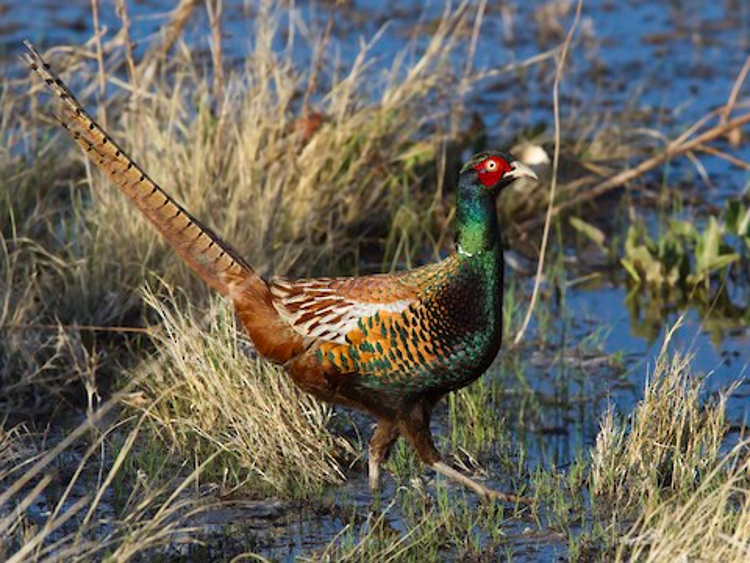
Common Pheasant, atypical dark morph male with largely dark-green underparts, rusty-brown upperparts, and white on the wings. (Bosque del Apache National Wildlife Refuge, New Mexico; April 3, 2018.) © Pierre Martin
Notes
Polytypic species consisting of approximately 30 recognized subspecies. The internal taxonomy is intrinsically complex and further complicated by many centuries of introductions and hybridization.
Traditionally considered conspecific with Green Pheasant (P. versicolor) of Japan, and hybridization occurs in captivity, but attempts to introduce Common Pheasants into the range of the Green Pheasant (mainly Honshu, Kyushu, and Shikoku) have failed, as have attempts to introduce Green Pheasant to areas occupied by Common Pheasant—which is now widely regarded as persuasive evidence that the two are separate species.
References
Alderfer, J., and J.L. Dunn. 2014. National Geographic Complete Birds of North America (Second Edition). National Geographic Society, Washington, D.C.
Brazil, M. 2009. Birds of East Asia. Princeton University Press, Princeton, N.J.
BirdLife International. 2016. Phasianus colchicus. The IUCN Red List of Threatened Species 2016: e.T45100023A85926819. https://dx.doi.org/10.2305/IUCN.UK.2016-3.RLTS.T45100023A85926819.en. (Accessed March 8, 2020.)
eBird. 2020. eBird: An online database of bird distribution and abundance. Cornell Lab of Ornithology, Ithaca, N.Y. http://www.ebird.org. (Accessed March 6, 2020.)
Madge, S., and P.J.K. McGowan. 2002. Pheasants, Partridges, and Grouse: A Guide to the Pheasants, Partridges, Quails, Grouse, Guineafowl, Buttonquails, and Sandgrouse of the World. Princeton University Press, Princeton, N.J.
McGowan, P.J.K., and G.M. Kirwan. 2020. Common Pheasant (Phasianus colchicus). In Handbook of the Birds of the World Alive (J. del Hoyo, A. Elliott, J. Sargatal, D.A. Christie, and E. de Juana, eds.). Lynx Edicions, Barcelona. https://www.hbw.com/node/53508. (Accessed March 8, 2020).
Mullarney, K., L. Svensson, D. Zetterström, and P.J. Grant. 1999. Birds of Europe. Princeton University Press, Princeton, N.J.
Pyle, R.L., and P. Pyle. 2017. The Birds of the Hawaiian Islands: Occurrence, History, Distribution, and Status. Version 2 (January 1, 2017). http://hbs.bishopmuseum.org/birds/rlp-monograph/. B.P. Bishop Museum, Honolulu, Hawaii.

